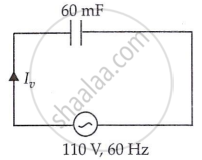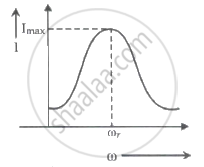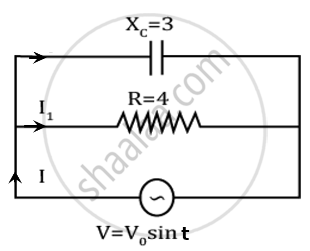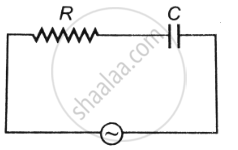Advertisements
Advertisements
Question
A 60 µF capacitor is connected to a 110 V, 60 Hz ac supply. Determine the rms value of the current in the circuit.
Solution

Capacitance of capacitor, C = 60 μF = 60 × 10−6 F
Supply voltage, V = 110 V
Frequency, f = 60 Hz
Angular frequency, ω = 2πr
Capacitive reactance Xc = `1/(ω"C")`
= `1/(2pi "fC")`
= `1/(2 xx 3.14 xx 60 xx 60 xx 10^-6)`
= 44.2 Ω
The rms value of current is given as:
`"I" = "V"/"X"_"c"`
= `110/44.2`
= 2.49 A
Hence, the rms value of the current is 2.49 A.
APPEARS IN
RELATED QUESTIONS
In a series RL circuit, the resistance and inductive reactance are the same. Then the phase difference between the voltage and current in the circuit is
How will you define RMS value of an alternating current?
Define inductive reactance and give its units.
Define capacitive reactance. Give its units.
Calculate the instantaneous value at 60°, average value and RMS value of an alternating current whose peak value is 20 A.
Predict the polarity of the capacitor in a closed circular loop when two bar magnets are moved as shown in the figure.

When does power factor of a series RLC circuit become maximum?
A choke coil in series with a lamp is connected to a dc line. The lamp is seen to shine brightly. Insertion of an iron core in the choke causes no change in the lamp’s brightness. Predict the corresponding observations if the connection is to an ac line.
The phase relationship between current and voltage in a pure resistive circuit is best represented by ______.
An alternating voltage source of variable angular frequency ‘w’ and fixed amplitude ‘V’ is connected in series with a capacitance C and electric bulb of resistance R(inductance zero). When ‘w’ is increased ______.
In an alternating current circuit consisting of elements in series, the current increases on increasing the frequency of supply. Which of the following elements are likely to constitute the circuit?
- Only resistor.
- Resistor and an inductor.
- Resistor and a capacitor.
- Only a capacitor.
For a series LCR circuit, I vs ω curve is shown:

- To the left of ωr, the circuit is mainly capacitive.
- To the left of ωr, the circuit is mainly inductive.
- At ωr, impedance of the circuit is equal to the resistance of the circuit.
- At ωr, impedance of the circuit is 0.
An inductor of 0.5 mH, a capacitor of 200 µF, and a resistor of 2Ω are connected in series with a 220V ac source. If the current is in phase with the emf, the frequency of ac source will be ______ × 102 Hz.
An alternating voltage v(t) = 220 sin 100πt volt is applied to a purely resistive load of 50 Ω. The time taken for the current to rise from half of the peak value to the peak value is ______.
A capacitor and resistor are connected with an AC source as shown in figure. Reactance of capacitor is XC = 3 Ω and resistance of resistor is 4 Ω. Phase difference between current I and I1 is approx ______.

A 50 Hz AC source of 20 volts is connected across R and C as shown in figure. The voltage across R is 12 volt. The voltage across c is ______.

A direct current of 4 A and an alternating current of peak value 4 A flow through resistance of 3Ω and 2Ω respectively. The ratio of heat produced in the two resistances in same interval of time will be ______.
A series CR circuit with R = 200 Ω and C = (50/π) µF is connected across an ac source of peak voltage ε0 = 100 V and frequency v = 50 Hz. Calculate (a) impedance of the circuit (Z), (b) phase angle (Φ), and (c) voltage across the resistor.
